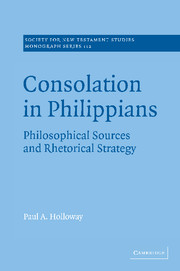Book contents
- Frontmatter
- Contents
- Acknowledgments
- Abbreviations
- Introduction
- Part I Literary and rhetorical contexts
- Part II Consolation in Philippians
- 4 Paul's consolatory strategy: discerning the things that matter (Phil. 1:3–11)
- 5 Discerning the things that matter in the gospel mission (Phil. 1:12–2:30)
- 6 Discerning the one thing that matters in the Christian life (Phil. 3:1–4:1)
- 7 Concluding parenesis, consolation, and thank-you note (Phil. 4:2–23)
- Conclusion: an analysis of Philippians
- Bibliography
- Index of modern authors
- Index of passages cited
7 - Concluding parenesis, consolation, and thank-you note (Phil. 4:2–23)
Published online by Cambridge University Press: 06 October 2009
- Frontmatter
- Contents
- Acknowledgments
- Abbreviations
- Introduction
- Part I Literary and rhetorical contexts
- Part II Consolation in Philippians
- 4 Paul's consolatory strategy: discerning the things that matter (Phil. 1:3–11)
- 5 Discerning the things that matter in the gospel mission (Phil. 1:12–2:30)
- 6 Discerning the one thing that matters in the Christian life (Phil. 3:1–4:1)
- 7 Concluding parenesis, consolation, and thank-you note (Phil. 4:2–23)
- Conclusion: an analysis of Philippians
- Bibliography
- Index of modern authors
- Index of passages cited
Summary
Pray to God and do not grieve.
Aesop, Fab. 288 HausrathLet us not overlook whatever is pleasant and attractive in our present circumstances.
Plutarch, De tranq. an. 469AWe come now to the conclusion of Paul's letter to the Philippians (4:2–23). The material may be divided into three parts: (1) concluding parenesis and consolation (4:2–9); (2) a postscripted “thank-you note” (4:10–20); and (3) final greetings (4:21–23). As usual, our exegesis will be selective. In particular, we are interested in (1) how Paul modifies the general parenesis of 4:2–9 to fit his immediate purpose of consolation, and (2) how in 4:10–20 he formally expresses his appreciation for the Philippians' most recent gift while not compromising his stand that he is – and they should be! – independent of such non-essentials.
Concluding parenesis and consolation (Phil. 4:2–9)
Paul frequently concludes his letters with a few words of general exhortation. He follows the same procedure in his letter to the Philippians, but with the exception that in Philippians his exhortations are more obviously linked to the specific circumstances of the letter. He first addresses a dispute between two prominent women in the church, Euodia and Syntyche (4:2–3), after which he offers several consolatory precepts (4:4–9).
- Type
- Chapter
- Information
- Consolation in PhilippiansPhilosophical Sources and Rhetorical Strategy, pp. 146 - 160Publisher: Cambridge University PressPrint publication year: 2001



